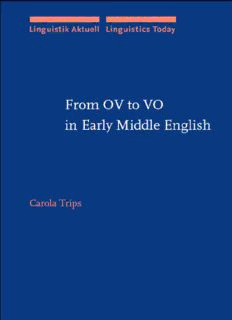
From OV to VO in Early Middle English (Linguistik Aktuell Linguistics Today) PDF
Preview From OV to VO in Early Middle English (Linguistik Aktuell Linguistics Today)
<ATSKSWVUIIDUEOZTIBYDOTEFLJWFHTECESHHCOOIEN"ETTRRFFI"rDG1Oo"""5SLHm4"0i"nT">"g"Ou"Vi2s2ti0tk"oAVkOtueilnl/LEinagrulyistMicsiddTloedaEyn,glVisohl"ume60" FromOVtoVOinEarlyMiddleEnglish Linguistik Aktuell/Linguistics Today Linguistik Aktuell/Linguistics Today (LA) provides a platform for original monograph studies into synchronic and diachronic linguistics. Studies in LA confrontempiricalandtheoreticalproblemsasthesearecurrentlydiscussedin syntax,semantics,morphology,phonology,andsystematicpragmaticswiththe aim to establish robust empirical generalizations within a universalistic perspective. SeriesEditor WernerAbraham UniversityofVienna AdvisoryEditorialBoard GuglielmoCinque(UniversityofVenice) GüntherGrewendorf(J.W.Goethe-University,Frankfurt) LilianeHaegeman(UniversityofLille,France) HubertHaider(UniversityofSalzburg) ChristerPlatzack(UniversityofLund) IanRoberts(CambridgeUniversity) KenSafir(RutgersUniversity,NewBrunswickNJ) LisadeMenaTravis(McGillUniversity) StenVikner(UniversityofAarhus) C.Jan-WouterZwart(UniversityofGroningen) Volume60 FromOVtoVOinEarlyMiddleEnglish byCarolaTrips From OV to VO in Early Middle English Carola Trips UniversityofStuttgart JohnBenjaminsPublishingCompany Amsterdam(cid:1)/(cid:1)Philadelphia TM ThepaperusedinthispublicationmeetstheminimumrequirementsofAmerican 8 NationalStandardforInformationSciences–PermanenceofPaperforPrinted LibraryMaterials,ansiz39.48-1984. LibraryofCongressCataloging-in-PublicationData CarolaTrips FromOVtoVOinEarlyMiddleEnglish / CarolaTrips. p. cm.(LinguistikAktuell/LinguisticsToday,issn0166–0829;v.60) Arevisionoftheauthor’sdoctoraldissertation,submittedtotheUniversityofStuttgart, 2001. Includesbibliographicalreferencesandindexes. 1.Englishlanguage--MiddleEnglish,1100-1500--Wordorder.I.Title.II.Linguistik aktuell;Bd.60. PE621 T75 2002 427’.02-dc21 2002034218 isbn90(cid:2)272(cid:2)2781(cid:2)0(Eur.)/1(cid:2)58811(cid:2)311(cid:2)6(US)(Hb;alk.paper) ©2002–JohnBenjaminsB.V. Nopartofthisbookmaybereproducedinanyform,byprint,photoprint,microfilm,orany othermeans,withoutwrittenpermissionfromthepublisher. JohnBenjaminsPublishingCo.·P.O.Box36224·1020meAmsterdam·TheNetherlands JohnBenjaminsNorthAmerica·P.O.Box27519·Philadelphiapa19118-0519·usa Table of contents Languageabbreviations xi Acknowledgments xiii Chapter1 Introduction Chapter2 ThedialectsofMiddleEnglish 2.1 Introduction 7 2.2 FromOldEnglishtoMiddleEnglish 8 2.2.1 Scandinavianinfluence 10 2.3 ThedialectsofMiddleEnglish 14 2.3.1 TheNortherndialect 18 2.3.2 TheEastMidlandsdialect 19 2.3.3 TheWestMidlandsdialect 21 2.3.4 TheKentishdialect 22 2.3.5 TheSoutherndialect 23 2.4 ThePenn-Helsinki-ParsedCorpusofMiddleEnglish2 (PPCME2) 24 2.4.1 Generalinformationaboutthecorpus 24 2.4.2 TheannotationschemeofthePPCME2 25 2.4.2.1 Part-of-Speechtags 25 2.4.2.2 Parsing 26 2.4.3 Howtosearchthecorpus 27 Chapter3 Syntacticchange 3.1 Introduction 37 3.2 Mechanismsofsyntacticchange 38 3.2.1 Internalmechanisms 39 Tableofcontents 3.2.1.1 Reanalysis 39 3.2.1.2 Extension 43 3.2.2 Externalmechanisms 44 3.2.2.1 Languagecontact 45 3.3 Syntacticchangeandfirst-languageacquisition 46 3.3.1 Acomputationalmodeloflearnability(Clark&Roberts 1993) 47 3.3.2 Cue-basedlanguageacquisition(Lightfoot1979, 1991,1999) 55 3.4 Syntacticchangeandlanguagecontact 63 3.5 Thespreadofsyntacticchange 68 3.6 Conclusion 72 Chapter4 WordorderchangeinEarlyMiddleEnglish 4.1 Introduction 75 4.2 WordorderinOldEnglish 76 4.2.1 OldEnglishdata 76 4.3 TheanalysesofOVwordorderinOldEnglish 79 4.3.1 Roberts(1997):OldEnglishasahead-initiallanguage 80 4.3.2 Pintzuk(1991):SynchronicvariationbetweenOVandVO wordorder 88 4.3.2.1 ThepositionofI◦ 89 4.3.2.2 TheunderlyingpositionofV◦ 95 4.4 TheanalysesofthechangefromOVtoVOinEarlyMiddle English 97 4.4.1 Roberts(1997):StrongAgrO◦waslost 97 4.4.2 Pintzuk(1991):HowtheDoubleBaseHypothesis accountsforthechangefromOVtoVOinEarly MiddleEnglish 101 4.5 OVandVOorderinEarlyMiddleEnglish 104 4.5.1 VariationbetweentextsfromtheWestMidlandsand SoutheastMidlandswithrespecttoOV/VOorder 105 4.5.2 OV/VOvariationintheOrmulum 110 4.6 AnoteonInfl-final/Infl-medialcompetitionintheOrmulum 115 4.7 Conclusion 117 Tableofcontents Chapter5 Objectmovement PartI: Objectshift 121 5.1 Introduction 122 5.2 Thedifferencesbetweenobjectshiftandscrambling 125 5.3 Theoriesofobjectshift 126 5.3.1 ObjectshiftisA-movement(Vikner1989,1990, 1994,1997) 126 5.3.1.1 Objectshiftdoesnotlicenseparasiticgaps 126 5.3.1.2 Caseassignment 127 5.3.1.3 ObjectShiftiscompatiblewiththeVP-internal subjecthypothesis 129 5.3.1.4 ObjectShiftrequiresthemainverbtomove 129 5.3.1.5 ObjectShiftofpronounsversusObjectShiftof DPsinIcelandic 131 5.3.1.6 Objectshiftindouble-objectconstructions 137 5.3.2 ObjectshiftisaPF-operation(Holmberg1999) 142 5.4 ObjectshiftintheOrmulum 152 PartII: Scrambling 163 5.5 Introduction 163 5.6 Thepropertiesofscramblingrevisited 166 5.7 Theoriesofscrambling 174 5.7.1 Themovementapproach:Scramblingaschainformation inthedomainoftheheadofaprojection(Haider& Rosengren1998) 176 5.7.1.1 Leftwardmovementofpronominalobjects 186 5.8 ScramblinginOldEnglishandMiddleEnglish 188 5.8.1 ScramblinginOldEnglish 188 5.8.1.1 ThedistributionoffullobjectDPs 189 5.8.1.2 Thedistributionofpronominalobjects 191 5.8.2 ScramblinginEarlyMiddleEnglish 197 5.8.2.1 ThedistributionoffullobjectDPs 198 5.8.2.2 Thedistributionofpronominalobjects 207 5.8.3 Scramblingandfrontingofpronominalobjectsinthe Ormulum 210 5.9 Conclusion 218 Tableofcontents Chapter6 V2andcliticisationofsubjectpronouns 6.1 Introduction 223 6.2 TheV2phenomenonintheGermaniclanguages 225 6.3 TheV2phenomenoninOldEnglish 230 6.3.1 Thedata 230 6.3.2 TheanalysesoftheOldEnglishV2pattern 236 6.3.2.1 AgrP-Recursion(Cardinaletti&Roberts1991) 236 6.3.2.2 V2takesplaceintheC-system(Roberts,1996) 239 6.3.2.3 ArevisionofPintzuk’sanalysis(Kroch&Taylor 1997) 241 6.4 TheV2phenomenoninEarlyMiddleEnglish:TwoV2 grammarsincompetition 246 6.4.1 TheV2syntaxofMiddleEnglishdialects 247 6.4.1.1 Thesoutherndialects 247 6.4.1.2 Thenortherndialects 251 6.5 V2andcliticisationintheOrmulum 262 6.6 Conclusion 270 Chapter7 Stylisticfronting 7.1 Introduction 275 7.2 Propertiesofstylisticfronting 279 7.2.1 Thesubjectgapcondition 279 7.2.2 Thecategoriesundergoingstylisticfronting 281 7.2.3 Maling’saccessibilityhierarchy 282 7.2.4 Stylisticfrontingisclause-bound 283 7.2.5 Theeffectsofstylisticfronting 283 7.2.6 Thecomplementarydistributionofstylisticfrontingand theexpletiveþaðinmainclauses 284 7.3 Theoriesofstylisticfronting 285 7.3.1 Movementtoaspecifierpositionorhead-adjunctionto I◦?(Rögnvaldsson&Thráinsson1990;Jónsson1991) 285 7.3.2 StylisticfrontingcheckstheP-featureinI◦(Holmberg 1997,2000) 295 7.4 StylisticfrontinginMiddleEnglishtexts 305 7.4.1 StylisticfrontingintheOrmulum 306 Tableofcontents 7.4.2 Thetheory:Stylisticfrontingasaprosodicphenomenon duetometricalreasons 314 7.4.2.1 ThemetreoftheOrmulum 315 7.4.2.1.1 Thebasicpattern 315 7.4.2.1.2 Therightedge 316 7.4.2.1.3 Theleftedge 317 7.4.2.1.4 Thefifthfoot 320 7.4.2.1.5 Thefourthfoot 320 7.4.2.2 Therelationbetweenstylisticfrontingandmetre intheOrmulum 322 7.5 Conclusion 328 Chapter8 Summaryandconclusions 331 Appendices 335 References 339 Index 351
Description: